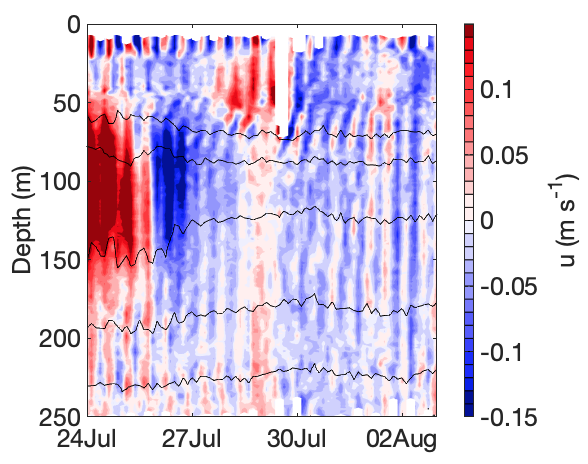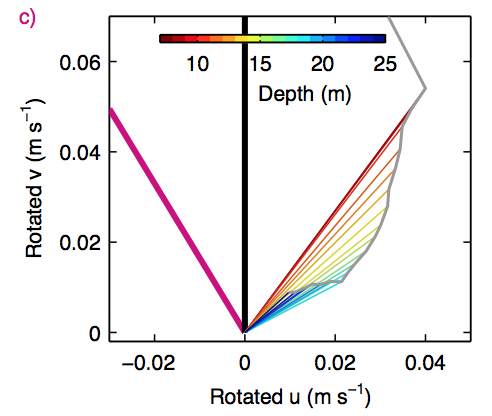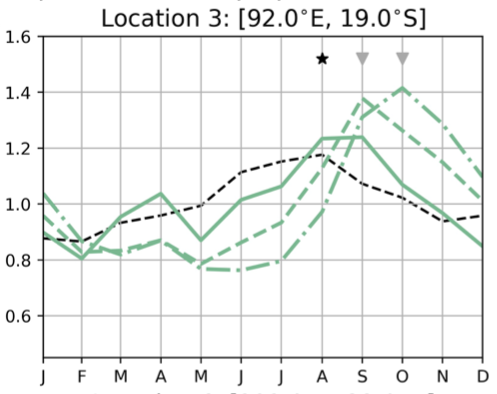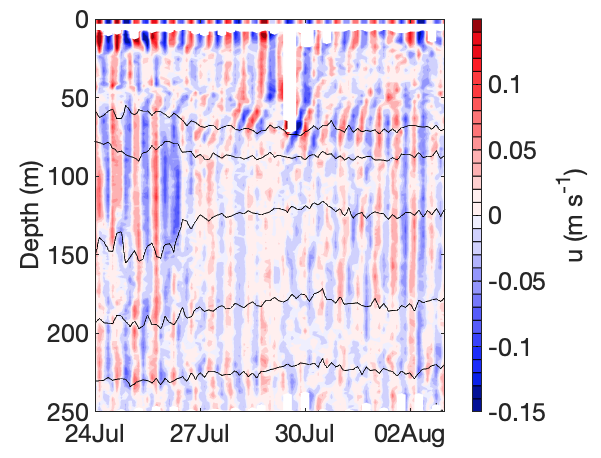Research Themes

In situ observations: Ice-Tethered Profilers
I collect and use Ice-Tethered Profiler and Ice-Tethered Profiler with Velocity observations in the Arctic Ocean. Observing Arctic Ocean temperature, salinity, and currents throughout the water column improves our understanding of heat, salt, and momentum exchanges between the ice and ocean, the evolution of the mixed layer, and watermasses and currents at depth.
Caption: Observed eastward ocean velocity in the Arctic over a two-week period in July 2014. Selected isopycnals are indicated in black. Eddies and internal waves are energetic features in the Arctic. From Cole et al. 2018.

Atmosphere-Ice-Ocean interactions
The Arctic Ocean and sea ice are coupled dynamically and thermodynamically in complex (and interesting!) ways. I investigate these dynamics from the scale of storms to the interannual changes currently underway, and from the turbulent boundary layer at the ice-ocean interface to the water masses and kinetic energy at depth within the ocean.
Caption: Observed currents beneath the Arctic sea ice show Ekman veering in the upper 20 m. Six months of observations in winter are shown. Individual profiles of wind, ice, and ocean velocity were oriented so that ice velocity was northwards and then averaged. Ocean velocity is shown at 1 m depth intervals. From Cole et al., 2014.

Horizontal stirring and diffusion
Horizontal stirring mechanisms set many of the ocean's properties. I directly estimate horizontal diffusivity and investigate submesoscale to mesoscale dynamics using in situ observations in the global ocean. The inverse cascade of energy from small to large scales is evident in surfce observations as a seasonal progression with large-scale eddy kinetic energy peaking latest in the year (Steinberg et al,. 2022).
Caption: Normalized mean seasonal cycle at one 5°x5° bin in the Indian Ocean. The potential to kinetic energy conversion rate (black, from Argo observations) peaks earliest in the year, with the kinetic energy at scales less than 60 km (solid), 140 km (dashed), and 300 km (dash-dotted, from along-track satellite observations) progressively reaching their seasonal maximum 1-3 months later. From Steinberg. et al., 2022.

Internal wave dynamics
The transfer of energy from winds and tides to internal waves and turbulence ultimately mixes the ocean in the vertical, affecting the global distribution of ocean properties. In the Arctic, I study the ways in which internal wave generation, propagation, and dissipation are modulated by ocean stratification or sea ice properties (e.g., ice concentration, ice floe size), and their relationship to vertical mixing.
Caption: High-pass filtered eastward ocean velocity in the Arctic over a two-week period in July 2014. Selected isopycnals are indicated in black. From Cole et al. 2018.